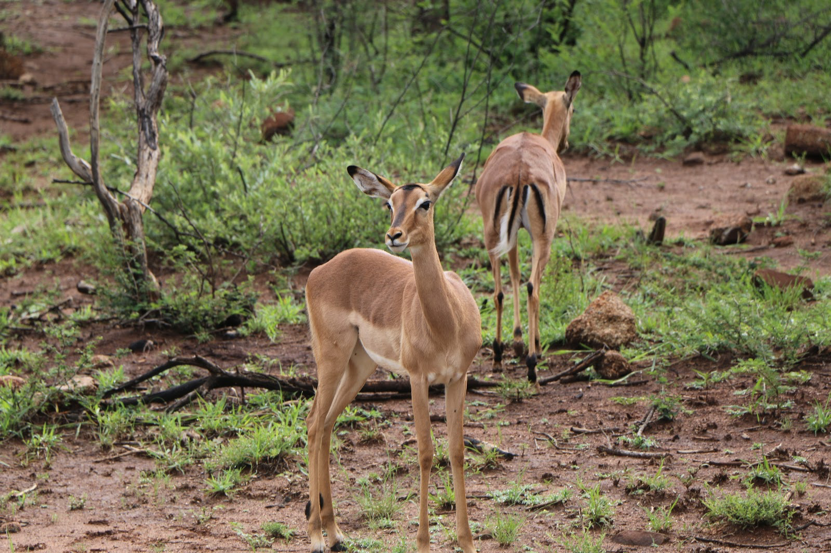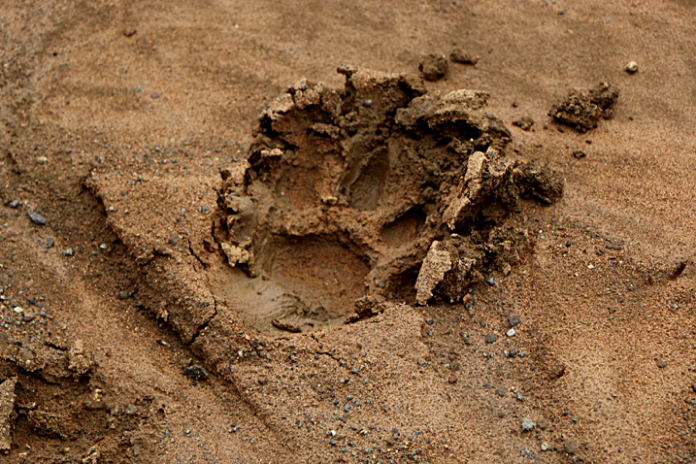Dear Traveler,
Although our view of the impala was brief you would have seen the markings on their backsides as they skimped away. These markings vaguely resembles an “M” or the golden arches of the McDonald’s logo. This adornment has led to them being the butt of many jokes, with this antelope being constantly referred to as “fast food” (clap, clap, so clever…). These markings are actually used to scare of predators as a flash of white or black can be startling in the bush, thus you will see this strategy used by a variety of buck in the Bushveld. However it is true that impala are incredibly fast and can leap a great distance in a single bound allowing them to escape relatively easily from predators such as lions.

Impala are incredibly successful in the bush resulting in a relatively large population. This is due to several factors such as living arrangements and gestation periods. Impala utilize group living as a strategy for survival.
Advantages of living in a group:
- Division of labour: Members of the group can keep guard while others snack.
- Predator evasion: reduces the chances of each individual Impala being caught by a predator
- Transfer of information: members can share information about location of resources.
- mate availability: there are more options available for mating and so a group member can save energy that would have otherwise been spent finding a mate.
Disadvantages:
- Transmission of diseases and parasites: living in close proximity to one another allows for easy transmission of parasites and disease between group members.
- More conspicuous: Living in group is equivalent to placing a large target on your back. As such predation on the group as a whole is increased
- Increased competition for resources or mates: the more members there are in the group the more pressure it puts on sharing resources.
Gestation:
Gestation only lasts six – seven months with a singe calve being produced. This is one of the reasons that impala are so successful as they produce offspring very quickly.
Group Structure:
Three a three types of group structures: Territorial males, bachelor herds and female herds. If you come across a singular impala in the bush it is most likely going to be a solitary male (territorial male). The composition of female herds are mainly dominated by female impala and their calves with one dominate male. The male calves will be kicked out the female herds at around 4-6 moths. The easiest way to tell the difference between sexes is that the male will grow horns and the female will not.
This behaviour and structure is very similar to another group living animal; the wildebeest.

So traveler, as we slowly inch the vehicle towards the sound it is with great sadness that we come across a wildebeest calf. The calf is clearly distressed and most frighteningly, alone. The calf is but a few days old and is incapable of defending itself in the wild. Do we capture the wildebeest and rear it until it can survive in the wild? or do we leave it to its unavoidable peril?

Unfortunately that is the circle of life, folks. Although one species may have lost a child another will be able to eat for the night.
We continue to drive, the call of the wildebeest slowly fades and our sprites begin to lift.
However, there appears to be something on the road.
As we pull closer we see a paw print. It is relatively fresh and leading in the direction that we are driving. Looking at the print with the image of the calf still fresh, fills us with terror and remembering the constant bleating of the frighten animal makes one thing clear in our minds. That is, that its life might come to an end much sooner than we thought.

Who pawed in the bush?
All will be revealed on Wednesday!
Really cool video of impala escaping predation:
Sources:
Hi Samantha, I have read all of the blogs so far. I am a wild life enthusiast and amatuer photgrapher I am medically retired and setting myself up to enjoy my future. I am impressed with your blog as it tells the story of the Pilanesberg from within the eyes of the viewer. you also supply the information required on the animals you are commenting on. I will continue to read your blogs as I enjoy the casual and informative way you write.
Keep up the good work our game parks require this kind of input to the world out there.
regards Tim Struwig – http://www.sarvguide.com – the website I have created for my RV travels.
LikeLiked by 1 person
Thank you so much for your feedback Tim! I am so glad you are enjoying the blog so far.
LikeLike
I think a lion is next,thoroughly enjoying my trip.
LikeLiked by 1 person